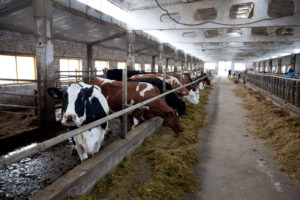Poultry and pork consumption volumes may become equal

Overall, he predicts that MEAT consumption in RUSSIA may increase to 83 kg per person this year, which is higher than the average consumption level in rich countries. Last year, consumption was at 80 kg. "Since 2014, meat consumption has been steadily growing, even in the years when disposable incomes of the population were declining, consumption of meat, as one of the most economically accessible products, increased," Yushin said.
According to the National Union of Pig Breeders, meat consumption last year was 81 kg per person against 79.5 kg in 2022 and 73.2 kg in 2014. In particular, pork consumption last year increased from 29.8 kg to 30.9 kg, accounting for 38% of the overall meat consumption structure. Poultry consumption in 2023 increased by 0.4 kg compared to 2022, to 35.4 kg.
Meat production continues to grow, including a significant contribution to the dynamics of the industry made by the food embargo introduced in August 2014. However, in general, Russian agriculture began to develop systematically back in the early 2000s with the launch of the national project, and then the state program for the development of agriculture, the HEAD of the NMA recalled. "The country's leadership understood perfectly well that dependence on imports would deprive it of the opportunity to conduct a sovereign foreign policy, so it took many other systemic measures," he noted. Thus, thanks to state support, over the past ten years alone, investments in livestock farming amounted to about 1.35 trillion rubles.
According to the NMA forecast, this year poultry production will increase to 5.3 million tons against 5.27 million tons in 2023, pork - from 4.7 million tons to 4.95 million tons, beef - from 1.65 million tons to 1.67 million tons. Compared to 2014, poultry production has increased by 1.3 times, pork - by 1.6 times. Although the dynamics for beef is less noticeable, the country provides itself with premium beef: if in 2014 3 thousand tons were imported, today it is consumed 15 times more, and this is meat of domestic production. "They began to revive the industry seven or eight years before the introduction of retaliatory economic measures, so by August-September 2014, decent volumes of Russian premium beef had already appeared," Yushin explained. In terms of poultry and pork production, Russia ranks fourth in the world, and is in the top 10 for beef.
Also, the turkey industry was created practically from scratch, including due to the food embargo. From 100 thousand tons in 2014, production increased to 422 thousand tons in 2023 and this year, according to forecasts, it will amount to 440 thousand tons. In terms of production of this type of meat, our country ranks second in the world and is its only supplier to the Chinese market.
EXPORTof all types of meat over the past ten years has increased from 135 thousand tons to 800 thousand tons (taking into account offal, finished products and live cattle - up to 1 million tons for $ 2 billion), imports have decreased from almost 2 million tons to 640 thousand tons. If Russia was once one of the largest importers of meat in the world, then in the last four years it has been a stable net exporter, Yushin emphasized. It is supplied to more than 60 countries on different continents. According to the head of the NMA, the Chinese market opens up great opportunities for Russian producers , which can become our key partner in this area. However, it is equally important to expand cooperation with the countries of South Asia and Africa, he added.
Tatyana Kulistikova
Read together with it:
- The IEA sees a risk of a decline in oil production in Russia due to sanctions.The IEA sees a risk of reduced oil production in RUSSIA due to US sanctions , but maintains its production forecast. According to the IEA, Russian oil exports will remain unchanged.There is a "significant downside risk" to Russia's oil production forecast due to US sanctions, the International Energy Agency (IEA) said in a report.BLOOMBERG . The agency's experts believe that the latest US sanction...
- "Коллективы АПК способны решать любые задачи даже в непростых условиях". Назаров о заслугах сельхозпроизводителейЮрий Назаров 13 ноября, Минск. Обеспечение продовольственной безопасности страны - большое достижение трудовых коллективов аграриев, отметил управляющий делами Президента Республики Беларусь Юрий Назаров на торжественной церемонии награждения государственными и иными наградами работников АПК Управления делами Президента Республики Беларусь, передает корреспондент БЕЛТА. Торжественная церемония наг...
- He crawled to the icon with prayer. The true story of a man who overcame drug addiction.Alexander Ovchinnikov. Topic News. Our project's hero was a drug addict for many years. The thought that this was a dead end never left him, but his addiction proved stronger. One day, when he could no longer walk, he crawled to an icon in prayer. This became his first step toward a new life. Today, he heads a charity center that helps those who have given up hope and are unable to quit ALCOHOL an...
- Russian agriculture: self-sufficiency continues to growThe industry has a track record of implementing new technologies and increasing productivity. RUSSIA is already confidently self-sufficient in grain, MEAT, fish, vegetable oil, and SUGAR. Grain and vegetable production is also forecast to be higher this year, despite unfavorable weather conditions in some regions. The Ministry expects historic highs for some crops and continues to support agricult...
- Sustainable growth of the food and processing industries in BashkortostanIlshat Fazrakhmanov, Deputy Prime Minister andThe regional Minister of Agriculture noted that the development of these industries provides the population with essential food products and contributes to increased exports. Since 2020, agricultural exports from the region have doubled. Since the beginning of 2......
- Низкое предложение и устойчивый спрос: в Аргентине растут цены на мясоЦены на говядину снова выросли, что отразилось на полках супермаркетов и в мясных магазинах. За последние две недели розничные цены выросли на 8–12%, а на некоторые популярные отрубы рост превысил 15% по сравнению с октябрем. Тем не менее, продажи остаются высокими: потребители продолжают покупать, принимая новые цены и закрепляя тенденцию, которая повторяется каждый год в конце года, когда спрос ...
- Смоленская область — лидер России по производству крольчатиныВ интервью «Агроэксперту» заместитель председателя регионального правительства Алексей Кучумов отметил, что регион достиг самодостаточности по таким продуктам, как яйца, мясо и картофель, превышая уровень 100%. Кроме того, Смоленская область занимает первое место по посевным площадям льна, а также активно развивает молочное животноводство, с общим поголовьем более 1......




























































